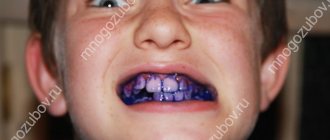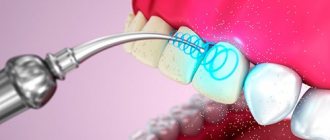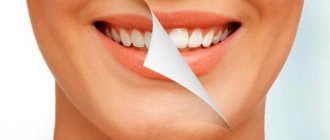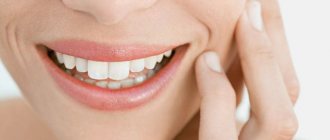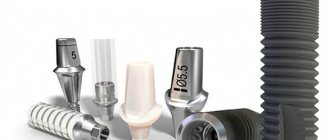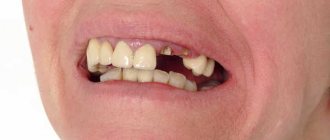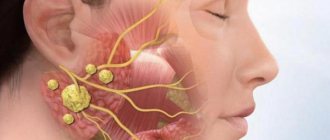Laser cleaning technology
Prevents the development of inflammatory processes in the gums. The beam destroys all bacterial and microbial infection that can cause dental abnormalities. During and after the manipulation there is no pain or bleeding of the gums.
In addition, the laser beam has a positive effect on cell regeneration and promotes the healing of microcracks in the oral mucosa. When exposed to laser, the enamel is not damaged or thinned.
During manipulation, deposits are destroyed and then washed off with water or air. The result is a clean surface that will absorb more beneficial microelements from pasta and food.
Advantages
Laser removal has the following positive aspects:
- The device operates in several modes. This allows you to remove even the most hardened plaque in hard-to-reach places.
- Helps strengthen gum tissue.
- Clears subgingival pockets of stones.
- Gently strengthens and cleanses the enamel without damaging it.
- The effect lasts throughout the year.
- The operation is silent.
- The surface is brightened by 1–3 tones, its natural shine returns.
Laser stone removal is the safest procedure, as it is performed without contact. Despite all the advantages, manipulation also has disadvantages.
Flaws
According to statistics, approximately 8% of patients cannot undergo lightening at all due to their natural yellowness. In addition, such cleansing has a number of contraindications. The procedure is performed only in stationary conditions.
And another undoubted disadvantage is the high cost. Not everyone can afford it. But if you think logically, is it necessary to save on health? After all, brushing is a way not only to make your smile snow-white, but also to prolong the health of your teeth. It is probably clear to everyone that the cost of restoration and treatment is much more expensive than the price of laser cleaning.
Ultrasound removal of dental plaque: technique
If you only have supragingival deposits and/or pigment plaque on your teeth, then the cleaning procedure usually only takes about 1 hour. With this type of deposits, ultrasonic cleaning can be carried out even by a regular dentist.
Important: but if you suffer from periodontitis (inflammation of the gums), then cleaning is best done by a periodontist. This will give a greater guarantee that you will then have subgingival dental plaque removed, and also, if necessary, prescribed a course of home anti-inflammatory therapy, which will include rinsing the mouth with antiseptics and applying gels to the gums.
Removing dental plaque with ultrasound consists not only of an ultrasonic cleaning procedure, but also the mandatory subsequent polishing of teeth, and ideally, also fluoridation. Below, we will talk in detail about the intricacies of each stage.
Stages
Professional treatment takes 40–60 minutes. The stone removal procedure is carried out in 6 stages:
- Using a special scale, the doctor determines the shade of natural enamel.
- If desired, soft plaque can be removed mechanically before treatment.
- Air-water removal of deposits.
- Laser beam cleaning.
- Grinding. This step is mandatory; it makes the surface smooth. This way, bacteria will have nothing to cling to.
- Fluoridation. At this stage, the doctor applies a special fluoride-containing gel, which becomes a protective barrier to infection. It, like a film, prevents bacteria from reaching the surface. The product is applied for 3 minutes, then removed using a special vacuum cleaner with a tiny nozzle.
Fluoridation is an optional step, but Dr. Zubastik recommends it. The protective gel makes it possible to forget about the dentist for a whole year and avoid negative consequences, for example, caries. The enamel will become strong, thanks to fluoride, the gel will protect against infection!
After bleaching, the doctor compares the new shade. If the result is not impressive, then the procedure is repeated. Maximum three times per session.
How is tartar removed?
At the Dentospas clinic, tartar removal is performed as a separate procedure or as part of professional comprehensive oral hygiene. We use several methods for this:
- mechanical. A special tool is used for this. These can be curettes, hooks of various shapes, hand scalers. Mechanical cleaning is carried out with a large thickness of solid deposits or for individual areas where their formation is accelerated. It is usually supplemented in other ways to improve the result and ensure a gentle effect on hard tissues;
- ultrasonic. The main method of removing soft and hardened plaque. Under the influence of ultrasonic waves they are destroyed and easily peel off from the surface. However, it is not damaged. Ultrasound additionally destroys bacteria and microbes, which reliably protects against inflammation or infection. Can be used for the main, root part of the crown, for the surface under the gingival margin;
- Air Flow. A gentle cleaning method in which a mixture of air and an aqueous solution of sodium bicarbonate is sprayed onto the surface of the teeth under pressure. The procedure is effective in case of soft plaque and small accumulations of tartar (it is destroyed into a powder and washed off). Dentists at the Dentospas clinic recommend using it if professional hygiene is performed regularly and there is no large amount of hard deposits on the teeth;
- periodontal cleaning. It is performed using a combined method (mechanical and ultrasonic) if tartar accumulates under the gingival margin. For mechanical cleaning, special curettes are used. Cleaning with an ultrasonic scaler usually completes the procedure, disinfecting the periodontal pocket that was opened during the procedure.
The procedure has contraindications:
- pregnancy and lactation;
- a large number of fillings, restored, prosthetic teeth;
- installed braces and other artificial structures in the mouth;
- hypersensitivity of gums or enamel;
- diseases of the cardiovascular system, respiratory organs;
- infections, viruses, hepatitis.
The Dentospas clinic performs tartar removal and additional procedures (grinding, enamel polishing, fluoridation, application of protective varnish). The cleaning usually requires one visit to the dental hygienist and lasts about an hour. The procedure is painless, does not cause discomfort, and can be performed using anesthesia.
Contraindications
Like any medical procedure, laser is no exception. Not carried out in the following cases:
- up to 18 years of age (since the enamel has not yet “strengthened” until this age);
- during lactation, during pregnancy;
- with diagnosed periodontitis;
- with braces (manipulation can be carried out after removal);
- if a person has implants or large, multiple fillings;
- with a pacemaker;
- with endocarditis, serious heart diseases;
- if the medical history is diagnosed with: bronchial asthma, AIDS, hepatitis, tuberculosis;
- with increased tissue sensitivity.
Relative contraindications are infectious diseases - ARVI, sore throat, pharyngitis, caries. After treatment, the procedure can be performed.
Price
Laser stone removal cannot be called cheap. Moreover, the cost depends directly on the status of the dental clinic - the higher, the more expensive.
The price is also affected by the complexity of the work; the number of stones being processed, the need for preliminary cleaning procedures. On average in Moscow, the cost varies from 10,000 to 24,000 rubles.
You need to know this
After removing the stone with a laser and applying a protective gel, you must adhere to the following rules to allow the fluoride-containing product to adhere to the enamel:
- within two weeks, give up food products that contain natural dyes - beets, carrots, herbs, coffee, tea, juices;
- do not eat for 2 hours after the procedure;
- after each meal, rinse your mouth or brush your teeth;
- use thread;
- undergo the procedure once a year.
You should clean not only your teeth, but also the inside of your cheeks and tongue. A large amount of bacterial infection accumulates there, which causes plaque. The latter, in turn, hardens within 10–15 hours, turning into stone.
It is no longer possible to remove solid deposits only with a brush and paste. Over time, the stone eats away at the surface, which leads to the development of caries.
Why is tartar removal necessary?
Improving the condition of the enamel. Due to hard deposits, saliva stops washing the enamel, the process of mineralization, saturation with fluoride and other substances is disrupted. The enamel softens and becomes vulnerable to the formation of caries. Solid deposits have a porous structure. Pathogenic bacteria actively develop inside them. This can provoke an inflammatory process, infectious damage to the mucous membranes, and the development of gingivitis.
Diagnostics. The dentist can assess the condition of the teeth only after professional cleaning. If deposits have accumulated in a large volume and are not removed for a long time, whitish spots form underneath them (the initial stage of caries), which then darken. If there is specificity in the formation of plaque (forms only on one side, in certain areas, etc.), this may indicate a malocclusion or other problems with the condition of the teeth.
Prevention of gum disease. Areas near the gum line are difficult to clean, so plaque accumulates there faster. It can also form under the edge of the gum, which over time leads to inflammation. Regular professional dental cleanings help keep your gums healthy.
Reduced enamel sensitivity. Under tartar, the enamel demineralizes, its resistance to temperature and acid irritants increases, and high sensitivity appears (sensation of stinging, aching upon contact with irritants). Performing professional hygiene followed by fluoridation normalizes sensitivity and helps restore its normal state.
Do you have questions about tartar removal?
We will call you back within 30 seconds
or call +7 (495) 373-10-25
By clicking the “Submit” button, you automatically agree to the processing of your personal data and accept the terms of the User Agreement.
Dr. Zubastik recommends
Stick to a white diet. Avoid not only coffee and tea, but also:
- Chocolate, cocoa-containing drinks.
- Ice cream with added coloring.
- Fruit drinks and wine.
- Grapes, cherries, cherries, strawberries, red plums.
- Adjika, soy sauce.
- Citrus fruits, sour fruits, vegetables.
But if you nevertheless neglected the rules and tried the above-mentioned foods and drinks, then immediately brush your teeth. The same applies to smoking. Otherwise, the snow-white effect will not please you for long. After 2 weeks, you can return to your normal lifestyle.
Look at an example of laser cleaning in this video:
If there are restrictions on this technique, use ultrasonic whitening or Air Flow.
Tags: laser cleaning, teeth cleaning
About the author: Dr. Zubastik
Typically, a toothache begins to subside on the way to the clinic and finally goes away after 10 minutes of sitting in line to see the dentist.
- Related Posts
- Proper care of braces: recommendations from dentists
- 12 best whitening toothpastes of 2020: which toothpaste is best for whitening teeth?
- Gently care for your teeth with cleansing foam
« Previous entry
Prices for professional teeth cleaning:
| Comprehensive oral examination | Diagnostics, development of treatment plan | 900 rubles FREE |
| Air Flow cleaning (removal of dental plaque) | One tooth | 75 rubles |
| All teeth | 2100 rubles | |
| Ultrasonic cleaning (tartar removal) | One tooth | 75 rubles |
| All teeth | 2100 rubles | |
| Comprehensive professional hygiene “7 stages” | Only for new patients with a 40% discount within 5 days from the date of initial application | 3000 rubles |
| Comprehensive professional hygiene “7 stages” | Soft plaque removal + sonic cleaning + ultrasound + AirFlow + polishing + fluoride varnish coating + oral hygiene training | 5000 rubles |
| Comprehensive professional hygiene “7 stages” for orthodontic patients | Soft plaque removal + sonic cleaning + ultrasound + AirFlow + polishing + fluoride varnish coating + oral hygiene training | 6000 rubles |
